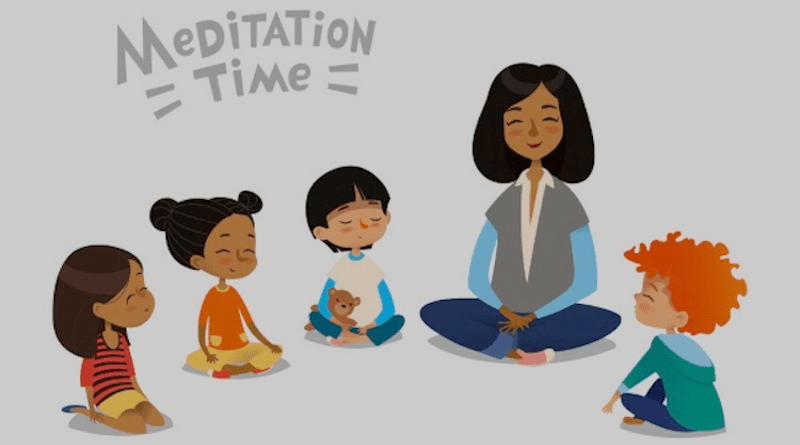A Timely Book To Encourage Teaching Of Mindfulness To Children – Book Review
By IDN
By Kalinga Seneviratne*
The recently published book ‘Developing Mindfulness in Young Children’ is a timely addition to educating our next generations to be responsible citizens in an increasingly anxious and uncertain world ripped apart by hatred and violence.
The author Shanti Hyacinth Senadeera (left) is a Sri Lankan born Australian early childhood education teacher with 35 years of experience in Sri Lanka, Nigeria and Australia.
“At the beginning, I used breathing exercises in my class to help transition the childrens’ mindset from morning to afternoon play sessions. It was difficult at the beginning as the children were very young, but their ability to concentrate and focus on their breathing gradually improved,” recalls Senadeera in the preface to the book.
“I received positive feedback from the children, as well as from their parents, on the benefits of these exercises. I realized that the children were capable of understanding far more than what would normally be expected of young children.”
It is this experience that prompted her to write this book in her retirement. Senadeera says that through her experience with young children, she has observed that developing mindfulness through meditation could assist them to deal with their emotions, mental stress and behavioural problems as well as develop patience and calmness.
Patience and calmness among people is a rare quality in today’s world. Thus, this is a book, or more a guide, for parents, teachers and caregivers to understand the fundamentals of mindfulness practice and its application into guiding young minds into the practice.
Though the mindfulness practice is rooted in the Buddhist teachings, while there is reference to it, Senadeera—who is herself a Buddhist—introduce the subject with a secular focus. In chapter 1, in her introduction to ‘what is mindfulness’ she explains: “Mindfulness practice cultivates universal human qualities and does not require anyone to change his or her cultural beliefs or religious faith.”
In the next chapter, she explains why Mindfulness is more important today more than ever, especially when “technology in our pockets have stolen our ability to relax”. Referring to recent studies, she points out how mindfulness practice promotes good health and wellbeing, while the secular nature of it encourages diverse range of people to adopt the practice without challenging their religious or cultural identities. Yet, she notes that the Buddhist teachings add an ethical lifestyle component to the practice.
In chapter 3, Senadeera offers advice on introducing mindfulness meditation to young children. Taking a scientific approach, she explains the relationship between breathing and the workings of the brain and gives some practical exercises to start the practice with children. Next chapter she discusses the regulating of emotions in children through the mindfulness practice, and here she draws from the Buddhist philosophy to explain the process.
“Young children are very curious and enthusiastic, but are very innocent and vulnerable,” argues Senadeera in the chapter. “They are also very self-centred and attached to their sense of self—me, my and mine”. Thus, developing mindfulness is “an excellent tool for them to understand the concept of self, in relation to other beings and recognize the world beyond themselves and their needs,” she notes.
Chapter 5 is basically instructions to teachers and parents on how to get started with teaching mindfulness meditation practices to small children such as sitting meditation, the introduction of posture —especially the Lotus Posture. Also, the use of a singing tone bowl and bead necklaces in meditation practice are discussed.
In the next chapter, Senadeera takes up the topic of how to train children to be patient. Some useful activities in developing patience in young children are introduced—such as planting seeds in cotton balls, watering and leaving it to germinate, then making charts of its progress on a daily basis. Reading appropriate stories is another exercise and listening to the dropping of rainwater could be another. “Patience is a powerful quality when it is understood argues Senadeera.
Chapter 7 goes into the Buddhist philosophy in developing—loving kindness. It is a practice that cultivates the feeling of kindness and compassion towards objects of attention—lo both people and other living beings. “Meta is a very valuable tool to cultivate in the young and youth today,” the author argues, pointing out to the news we hear often of gang violence and school shootings.
“Youth are suffering from mental health issues and using various dangerous drugs for relief. This is due to the hatred and anger they have accumulated in their minds,” she notes. The chapter gives a guide to loving-kindness meditation and a list of its benefits.
Chapters 8 to 10 deals with various techniques of mindful meditation such as walking meditation that could be done through a guided walk teaching children to be aware of their footsteps; while body scan meditation is a technique where the instructor/teacher guides the children through an exercise that concentrates on their body parts, usually starting from the feet and ending with the head.
Chapter 10 is about mindfulness eating which is designed for the teachers and parents with a brief explanation of the biology of the digestive system. Some tips are given to increase the child’s awareness when eating.
The final two chapters discuss the integration of Mindfulness into the education system. In conclusion Senadeera says: “The great quality about mindfulness is that it can be practiced by anyone, regardless of religious background or beliefs. We can all benefit by feeling appreciation and gratitude for everyday gifts that life has to offer.”
She believes that there are endless opportunities to be mindful in the moment, mindful of oneself, and mindful of others. “If everyone practices these concepts, this may ultimately give greater help, happiness, and freedom for all beings,” says Senadeera.

